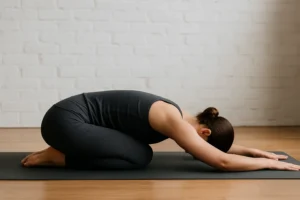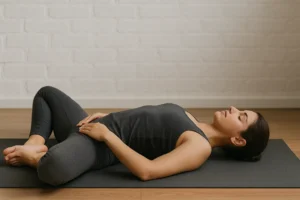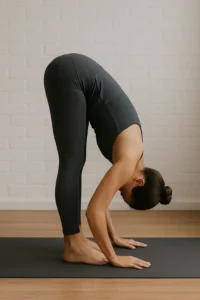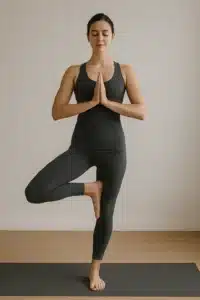Many people turn to yoga poses for anxiety to calm the nervous system and ease mental distress.
Anat Joseph, LCSW, PsyA, draws on her clinical expertise to highlight how integrating body and breath can support emotional regulation, especially for those managing an anxiety disorder.
This article outlines the best yoga moves and routines to safely and effectively reduce anxiety.
Quick Picks for Fast Relief
For readers seeking quick answers, this section highlights targeted yoga poses tailored to specific anxiety-related needs.
- Best for panic: Legs-Up-the-Wall
- Best before sleep: Reclined Butterfly
- Best for beginners: Child’s Pose
- Best for emotional grounding: Tree Pose
- Best short routine: 10-Minute Flow at Home
- Best for combined stress and anxiety relief: Standing Forward Fold
How Yoga Helps with Anxiety, Depression, Panic, and Sleep
Yoga does more than stretch muscles—it supports emotional regulation and nervous system balance.
Understanding its physiological and psychological effects helps explain why it’s so effective for managing anxiety symptoms.
Yoga fosters a connection between the body and mind. When practiced consistently, it helps reduce stress and anxiety by activating the parasympathetic nervous system.
This slows the heart rate, lowers cortisol levels, and promotes emotional stability. For individuals facing an anxiety disorder, practicing yoga encourages self-regulation through movement, breath, and body awareness.
While yoga offers physical and emotional benefits, it can also be combined with therapies such as Cognitive Behavioral Therapy (CBT), psychoanalysis, or psychodynamic treatment for even deeper support.
If you experience physical symptoms such as a rapid heart rate, breathing difficulties, or insomnia, consult your physician before starting any physical activity.
What Are the 3-3-3 and 5-5-5 Anxiety Methods?
These techniques are commonly used to interrupt anxious thought cycles. They complement yoga by grounding attention and regulating breath.
The 3-3-3 rule helps ground anxious thoughts by asking you to name 3 things you see, 3 sounds you hear, and move 3 parts of your body.
It shifts attention outward and interrupts spiraling thoughts.
The 5-5-5 method involves breathing: inhale for 5 seconds, hold for 5 seconds, exhale for 5 seconds. This slows the breath and engages the vagus nerve, supporting calm.
These techniques align well with a yoga practice, which often involves similar grounding and breath-focused awareness.
Incorporating either into a yoga session can enhance its calming effects.
These practices are especially helpful if you struggle with racing or unwanted thoughts.
Learn how to stop intrusive thoughts and regain control with practical strategies grounded in therapy.
Top Calming Yoga Poses to Practice
These yoga poses support the body in reducing stress and anxiety symptoms through mindful movement, grounding, and breath awareness. They are accessible for all levels and easily adapted.
What Is the Best Yoga Pose for Anxiety?
There’s no single best yoga pose for anxiety, but many practitioners and therapists recommend Child’s Pose or Legs-Up-the-Wall (Viparita Karani) for immediate relief. Both poses are easy to enter, support deep breaths, and bring the nervous system into a resting state.
Child’s Pose (Balasana)

- Start on your hands and knees, then bring your big toes touching and sit back onto your heels.
- Lower your torso forward, resting your forehead on the mat with your palms face down.
- Hold the pose for 2–3 minutes, breathing slowly.
Benefits:
- Calms the nervous system
- Gently stretches the back
- Reduces heart rate and mental noise
- Supports grounding and a sense of safety
Legs-Up-the-Wall Pose (Viparita Karani)

- Sit next to a wall and lie back, swinging your legs up so they rest vertically.
- Keep your arms at your sides with palms face up.
- Hold for 5–10 minutes, focusing on slow, steady breathing.
Benefits:
- Slows the heart rate
- Supports lymphatic drainage
- Promotes deep relaxation
- Eases feelings of panic or fatigue
- Helpful in reducing insomnia and calming the body at night
Reclined Butterfly (Supta Baddha Konasana)

- Lie on your back and bring the soles of your feet together, letting your knees fall open.
- Rest your hands on your chest and belly, and focus on your breath.
- Hold for 3–5 minutes. Use props under the knees if needed.
Benefits:
- Releases hip tension
- Opens the chest for deeper breathing
- Calms emotional overwhelm
- A restorative option before sleep or meditation
Standing Forward Fold (Uttanasana)

- Stand tall, fold forward from the hips, and let your arms hang.
- Soften your knees slightly. Let your head drop.
- Hold for 1–2 minutes, breathing deeply.
Benefits:
- Calms the brain and stretches the spine
- Relieves tension in the neck and back
- Encourages an inward focus
- Effective when transitioning between stress and stillness
Tree Pose (Vrksasana)

- Stand on one leg and place the opposite foot on your inner thigh or calf.
- Bring your palms together at your chest or raise them overhead.
- Hold for 30–60 seconds on each side.
Benefits:
- Ground your body
- Enhances balance and focus
- Restores confidence and stability
- Encourages emotional steadiness in challenging moments
Yoga Poses for Panic Attacks, Sleep, and Relaxation
Some yoga poses are particularly beneficial in moments of high emotional intensity or just before going to bed. These poses support nervous system recovery.
For panic attacks, stillness and gentle inversions like Legs-Up-the-Wall or Reclined Butterfly help lower your heart rate and stabilize your nervous system.
For sleep support, use poses like Seated Forward Fold, Reclining Twist, and Corpse Pose (Savasana) before bed. These promote calm and help the body wind down.
Many of these gentle postures are also recognized as effective yoga poses for stress and anxiety, making them suitable for daily use or in moments of emotional overwhelm.
Corpse Pose (Savasana)
- Lie on your back with arms and legs extended, palms face up.
- Close your eyes and take deep, steady breaths.
- Stay in the pose for 5–10 minutes.
Benefits:
- Deep relaxation
- Nervous system reset
- Prepares the body for rest or meditation
- A quiet finish to any yoga session
Many use Savasana as a gateway into stillness or meditation. If you’re curious about the mental benefits, read more on why meditation is important to emotional regulation.
Beginner Yoga Poses to Reduce Anxiety
These foundational poses are ideal for beginners. They are low-risk, easy to follow, and still offer significant mental and physical benefits.
These yoga asanas for anxiety are designed to be accessible while providing meaningful support for the nervous system.
- Cat-Cow (Marjaryasana/Bitilasana): Move between arching and rounding the spine on all fours. Coordinates breath with movement.
- Mountain Pose (Tadasana): Stand tall with feet grounded and arms by your side. Breathe slowly and evenly.
- Seated Breathing: Sit with your spine straight and focus on your breath. Try inhaling for 4 counts and exhaling for 6.
These yoga moves for anxiety are simple and help you stay connected to the present moment.
Quick Yoga Routines and Breathing Techniques
Simple, structured routines can make yoga practice more sustainable. These flows are designed for anxiety relief in under 15 minutes.
10-Minute Routine for Anxiety Relief
A short sequence for any time of day:
- Child’s Pose – 2 minutes
- Cat-Cow – 1 minute
- Standing Forward Fold – 2 minutes
- Legs-Up-the-Wall – 3 minutes
- Savasana – 2 minutes
Total time: 10 minutes.
This routine helps release tension, regulate breathing, and ground the body. It’s ideal for mid-day resets or evening wind-downs.
Daily Yoga Sequence to Stay Calm
Establishing a rhythm in your yoga practice strengthens its calming effects over time. Here’s a structure you can follow.
- Morning: Mountain Pose, Cat-Cow
- Afternoon: Tree Pose, Seated Forward Fold
- Evening: Reclined Butterfly, Savasana
A simple yoga practice like this can enhance focus, alleviate stress, and foster a sense of emotional well-being.
After even a brief session, you may start to feel good physically and emotionally—more grounded, clear-headed, and connected.
Breathing and Grounding Exercises That Help
Breathing is the foundation of every yoga session. These focused techniques are simple and effective tools for immediate relief.
- Box Breathing: Inhale–hold–exhale–hold for 4 seconds each
- Long Exhale: Inhale for 4, exhale for 6
- Hand-to-Heart: Place one hand on the heart, one on the belly, and focus on your breath
Breathwork supports nervous system regulation and pairs well with yoga positions for anxiety. You can use these on their own or alongside any pose.
For more ideas, try these mindfulness exercises for anxiety that complement your yoga routine and deepen your breath awareness.
Expert Advice on Safe Practice
Proper guidance is essential to practicing yoga safely and effectively. These tips help prevent discomfort and encourage a positive experience.
Tips for Beginners
- Start with simple poses and short sessions
- Use props for comfort and stability
- Avoid pushing into discomfort
- Focus on steady breathing, not perfection
When to Seek Professional Support
Yoga is a helpful tool, but not a substitute for therapy. If anxiety symptoms persist or worsen, reach out to a licensed therapist.
Anat Joseph, LCSW, PsyA, incorporates body-based methods like yoga into her psychotherapy work, offering clients integrative support for anxiety and emotional regulation.
Her clinical perspective reinforces the value of yoga as part of a holistic treatment approach.
How Often to Practice Yoga for Anxiety
Start with 10–20 minutes, 3–5 times per week.
Gradually build consistency.
Focus on how the poses make you feel rather than achieving exact form. It’s better to move mindfully than to rush through a routine.
Your Next Steps: Guidance and Support
You don’t need a perfect routine—just one calming pose and a few quiet minutes. Start with Legs-Up-the-Wall or Child’s Pose and let your breath guide you.
Anat Joseph, LCSW, PsyA, is a licensed clinical social worker and psychoanalyst practicing in New York and New Jersey.
She integrates talk therapy with body-based methods to support lasting emotional well-being.
To explore how yoga-informed therapy can help you, consider scheduling an appointment with Anat Joseph. Her approach combines talk therapy with body-based practices to support lasting emotional well-being.
Because Your Happiness Matters.

